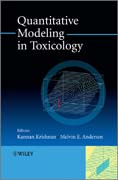
Governments around the world are passing laws requiring industry to assess the toxicity of the chemicals/products they produce, but to do so while reducing, refining, or even replacing testing on animals. To meet these requirements, experimental toxicologists and risk assessors are adopting quantitative approaches and computer simulations to study the biological fate and effects of chemicals and drugs. In Quantitative Modeling in Toxicology leading experts outline the current state of knowledge on the modeling of dose, tissue interactions and tissue responses. Each chapter describes the mathematical foundation, parameter estimation, challenges and perspectives for development, along with the presentation of a modeling template. Additionally, tools and approaches for conducting uncertainty, sensitivity and variability analyses in these models aredescribed. Topics covered include: modeling dose: human exposure and multiroute absorption; pharmacokinetic and PBPK modeling; modeling of PK interactions in mixtures; reverse PK modeling and interpretation of biomonitoring data modeling tissue interactions: receptor/reversible interactions including protein induction; cytotoxicity; macromolecular binding/colalent binding; gene and protein expression; signal transduction modeling tissue responses: cholinesterase inhibition; methemoglobin induction; thyroid uptake and release of hormones response; QSAR models of adverse responses; reproductive and developmental toxicology; biologically-based cancer models; tissue response modeling based on in vitro data; and the statistical and physiological modeling of the toxicity of chemicals in mixtures model evaluation and applications: quantitative modelingin cancer and non-cancer risk assessment; uncertainty, variability and sensitivity analyses in simulation models; current approaches and challenges in model validation and evaluation; and the evaluation of simulation models intended for application in risk assessment A website containing the model codes accompanies the book to help the reader reconstruct the models described and discussed in the various chapters. Quantitative Modeling in Toxicology serves as an essential reference source and tool box for risk assessors and researchers and students in toxicology, public health, pharmacology, human toxicology and ecotoxicology who are interested in developing quantitative models for a better understanding of dose-response relationships.Dr. Kannan Krishnan Director of Human Toxicology Research Group (TOXHUM), Université de Montréal, Canada An expert in pharmacokinetics/toxicokinetics, toxicology of chemical mixtures, computational toxicology, and health risk assessment methods, Dr. Krishnan has been the leader of the risk assessment methodologies theme team of the Canadian Network of Toxicology Centers, member of the U.S. National Academy of Sciences Sub-committee on Acute Exposure Guideline Levels, President of the Risk Assessment Specialty Section of the Society of Toxicology, and advisor for the International Programme on Chemical Safety (IPCS) of WHO. He is a member of the editorial boards of Toxicological Sciences, International Journal of Toxicology, Journal of Applied Toxicology and Journal of Child Health. Dr. Melvin E. Andersen CIIT Centers for Health Research, Research Triangle Park, NC. Dr. Andersen is (1) the Director, Computational Biology Division, (2) Director, LRI-ACC Research Program and (3) Science Advisor, Center for Human Health Assessment at CIIT Centers for Health Research, Research Triangle Park, NC. Between 1971 and 1994, he held positions in toxicology research and research management in the federal government (DoD and US EPA) and in private industry (Chemical Industry Institute of Toxicology). He is recognized for developing short-courses and computer demonstrations in pharmacokinetic and pharmacodynamic modeling. He has received several awards for professional contributions, is a Fellow of the Academy of Toxicological Sciences and is recognized as a highly cited scientist by the Institute for Scientific Information.
- ISBN: 978-0-470-99809-0
- Editorial: John Wiley & Sons
- Encuadernacion: Cartoné
- Páginas: 512
- Fecha Publicación: 26/03/2010
- Nº Volúmenes: 1
- Idioma: Inglés
